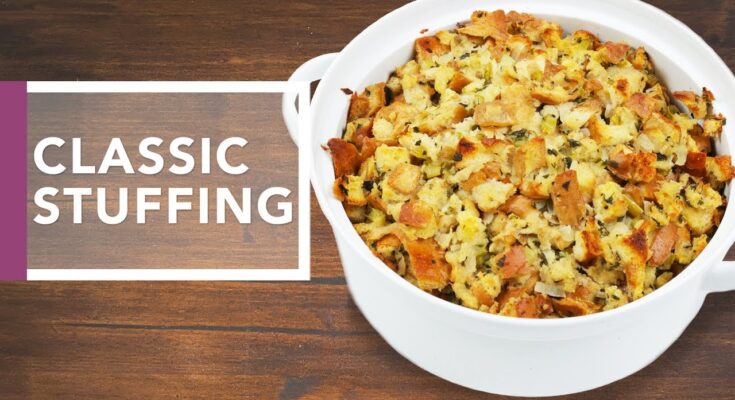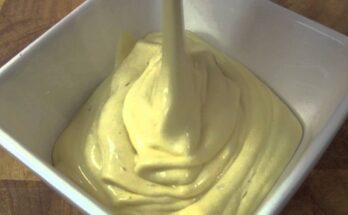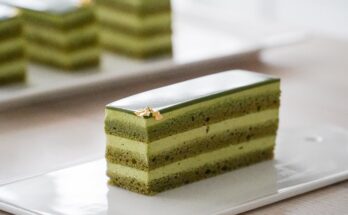Traditional Stuffing Recipe: Stuffing is more than just a side dish – it’s a warm, nostalgic bite of comfort that completes a holiday meal. Traditionally served during Thanksgiving or Christmas, stuffing is a savory mix of dried bread cubes combined with a flavorful blend of herbs, vegetables, and broth. Whether baked inside a turkey or in its own dish, it delivers rich, savory flavors that guests look forward to year after year.
The charm of stuffing lies in its flexibility and homey goodness. It brings together simple ingredients and turns them into a flavorful, hearty dish. Each bite is packed with textures – crunchy on top, soft and moist inside. For many, it’s the highlight of the holiday feast.
Brief History of Stuffing
The roots of stuffing go deep into history, all the way to ancient Roman times when chefs filled roasted animals with herbs, vegetables, and grains. Over centuries, this idea evolved across cultures, and today, in American cuisine, it’s an essential part of holiday meals. What started as a way to flavor meat from the inside has become a standalone favorite for millions.
Ingredients for Traditional Stuffing
Bread – The Heart of the Dish
The most important ingredient in traditional stuffing is the bread. It forms the base, soaking up all the delicious flavors and providing the perfect texture. Day-old or dried bread is best because it holds its shape better and absorbs the broth more effectively. You can use white bread, sourdough, or even a mix of different types.
Cut the bread into ½-inch to 1-inch cubes and let it sit out overnight, or toast it in the oven for about 10–15 minutes at 300°F (150°C) until dry. This is crucial for that perfect stuffing texture – not too mushy, not too dry.
Aromatics – Onion, Celery, and Garlic
No traditional stuffing is complete without aromatics. These are the flavor builders of your dish. Yellow onions, chopped celery, and a few cloves of garlic are sautéed in butter until tender. This combination gives stuffing its iconic savory aroma and depth of flavor.
The smell of onion and celery sizzling in butter is a memory trigger for many – it’s the start of the holiday cooking magic. Always cook them until soft and translucent to avoid crunchy veggies in your final stuffing.
Herbs and Seasonings for That Signature Flavor
Herbs like sage, thyme, and parsley bring that unmistakable stuffing taste. Sage, in particular, is key to traditional stuffing. It gives that earthy, slightly peppery note that feels instantly familiar. You can use fresh or dried herbs, though fresh offers more vibrant flavor.
Other seasonings to consider include salt, black pepper, and sometimes a bit of poultry seasoning. These elevate the bread and broth from bland to festive and comforting.
Broth and Butter – Moisture Magic
The final essential ingredients are broth and butter. They give stuffing its signature moist, rich texture. Chicken or vegetable broth works best. Use low-sodium if you want more control over saltiness. Melted butter adds richness and helps bind everything together.
Pour the warm broth over the bread mix gradually while stirring, making sure everything is evenly moistened but not soaked. Too much broth and you’ll get mushy stuffing; too little and it’ll be dry.
Preparation Steps
Step 1: Choosing and Prepping Your Bread
Start with a good quality loaf of bread. Avoid pre-sliced sandwich bread if you can – artisan or bakery bread gives more flavor and texture. Cube it into uniform pieces so it cooks evenly. Dry it overnight or bake in the oven to remove moisture. This prevents sogginess and allows it to absorb the broth properly later on.
You’ll need about 10 cups of cubed bread for a standard recipe serving 6–8 people.
Step 2: Sautéing the Aromatics
Heat a large skillet over medium heat and melt ½ cup (1 stick) of unsalted butter. Add 1 ½ cups chopped onion and 1 ½ cups chopped celery. Cook for 8–10 minutes until soft and fragrant. Add 2–3 minced garlic cloves and cook for 1 more minute.
This step builds the flavor foundation of your stuffing. Make sure not to brown the vegetables – you want them soft and just starting to caramelize for sweetness.
Step 3: Mixing Everything Together
In a large mixing bowl, combine the dried bread cubes with the sautéed vegetables. Add 2 tablespoons of chopped fresh sage, 1 tablespoon of thyme, and ¼ cup of parsley. Season with 1 teaspoon of salt and ½ teaspoon of pepper.
Gradually pour in 2 to 2½ cups of warm chicken or vegetable broth, mixing gently. You want the bread to be moist but still hold its shape. Let it rest for a few minutes to absorb the liquid fully.
Step 4: Baking to Perfection
Once your stuffing mixture is well combined and moistened just right, it’s time to bake. Preheat your oven to 350°F (175°C). Grease a 9×13 inch baking dish with a bit of butter or cooking spray, then spread the stuffing evenly into the dish. For extra flavor and a crispy top, dot a few small pieces of butter over the surface before baking.
Cover the dish with foil and bake for 30 minutes. Then, remove the foil and bake for an additional 15–20 minutes, or until the top is golden brown and slightly crispy. The center should be hot and tender, not dry.
If you prefer a softer stuffing, keep it covered the entire time. For a crustier version, let it bake uncovered for the last 20–25 minutes. Either way, the end result should be aromatic, flavorful, and utterly irresistible.
Pro Tips for the Best Stuffing Ever
Variations You Can Try
While traditional stuffing is delicious on its own, there’s always room to get creative. Want to jazz things up? Try adding:
- Sausage: Brown some Italian or breakfast sausage and mix it in for a heartier stuffing.
- Dried fruit: Chopped dried cranberries, apricots, or raisins can add a touch of sweetness that contrasts beautifully with savory herbs.
- Nuts: Toasted pecans or walnuts offer crunch and nuttiness.
- Mushrooms: Sautéed mushrooms deepen the umami flavor.
- Apples: Small diced apples add a fresh, tart bite.
You can also experiment with different types of bread – cornbread, whole wheat, or even brioche. Each brings its own unique texture and taste.
How to Store and Reheat Stuffing Properly
Got leftovers? Lucky you. Stuffing stores well and can be just as tasty the next day. Here’s how:
- Storing: Allow the stuffing to cool completely, then transfer it to an airtight container. Refrigerate for up to 4 days.
- Freezing: You can also freeze stuffing. Place it in a freezer-safe bag or container and freeze for up to a month. Thaw overnight in the fridge before reheating.
- Reheating: Warm it in the oven at 350°F (175°C) covered with foil until heated through, about 20–30 minutes. To keep it from drying out, splash a bit of broth over the top before baking.
Avoid microwaving if possible – it can turn the stuffing rubbery or unevenly heated. The oven method is best for retaining that perfect texture.
FAQs about Traditional Stuffing Recipe
Q1: What is traditional stuffing made of?
Traditional stuffing typically includes bread cubes, onions, celery, butter, chicken broth, and herbs like sage, thyme, and parsley. Some variations may also include eggs, sausage, or nuts for added flavor and texture.
Q2: Can I make stuffing ahead of time?
Yes, you can prepare stuffing a day in advance. Simply assemble the ingredients, cover, and refrigerate. Bake just before serving to keep it moist and flavorful.
Q3: What kind of bread is best for stuffing?
Day-old white bread, sourdough, or French bread works best. They absorb the broth well without getting too mushy.
Q4: Can I cook stuffing inside the turkey?
Yes, but it must reach an internal temperature of 165°F (74°C) to be safe. However, baking stuffing in a separate dish ensures even cooking and a crispy top.
Q5: How do I keep stuffing from drying out?
Cover the dish with foil while baking and add extra broth if needed. For a crispy top, remove the foil during the last 15 minutes of baking.
Q6: Is there a vegetarian version of traditional stuffing?
Absolutely! Use vegetable broth instead of chicken broth and skip any meat-based ingredients. Add mushrooms or nuts for extra depth.
Conclusion
A traditional stuffing recipe is more than just a side dish – it’s the soul of the holiday table. With its crispy edges, moist center, and blend of savory herbs and buttery goodness, it brings warmth and nostalgia to every bite. Whether you’re sticking to the classic or adding your own twist, this step-by-step guide gives you everything you need to master the ultimate holiday favorite.
Take your time with each step, use quality ingredients, and don’t forget to taste along the way. The joy of making stuffing comes not just from eating it but from the aromas filling your kitchen and the memories it helps create around the table.



